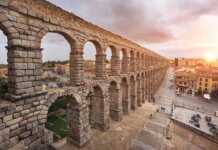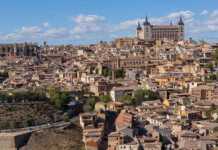Champagne, crepes and croissants are some of the delicious things that attract visitors to France. Then there’s fine French food, fashion and a treasure trove of historic sights to explore. There’s no doubt la vie est belle! Yes, life is beautiful indeed and so are the most famous landmarks in France. The landmarks in Paris alone could fill your entire visit but take heed of this quote about travel by songwriter Gustave Nadaud: “To be is to exist, but to travel is to live” and you’ll be living in the footsteps of royalty as you discover lavish castles, forts and palaces. Of course, there’s the Eiffel Tower and natural landmarks in France like Mont Blanc. These French treasures are so captivating they might leave you no time to do anything else.
Contents
- 30 Landmarks in France
- Paris Landmarks
- Famous Landmarks In France
- 9- Château de Fontainebleau
- 10- Palace of Versailles
- 11- Mont Saint Michel
- 12- Palais des Papes
- 13- Basilica of Notre-Dame de Fourvière
- 14- The Walls of Carcassonne
- 15- Pont du Gard
- 16- Mont Blanc
- 17- Château de Chenonceau
- 18- Château de Chambord
- 19- Chateau de Chantilly
- 20- Place Massena
- 21- Place de la Bourse in Bordeaux
- 22- Cistercian Abbey of Fontenay
- 23- Tour First
- 24- Bourges Cathedral
- 25- Pilat Dune
- 26- Massif des Calanques
- 27- The Beach of Omah
- 28- Strasbourg Cathedral of Notre Dame
- 29- European Court of Human Rights
- 30- Lavender Fields in Provence
30 Landmarks in France
Paris Landmarks
Of the many amazing landmarks in France, the monuments in Paris are some of the most iconic.
1- Eiffel Tower
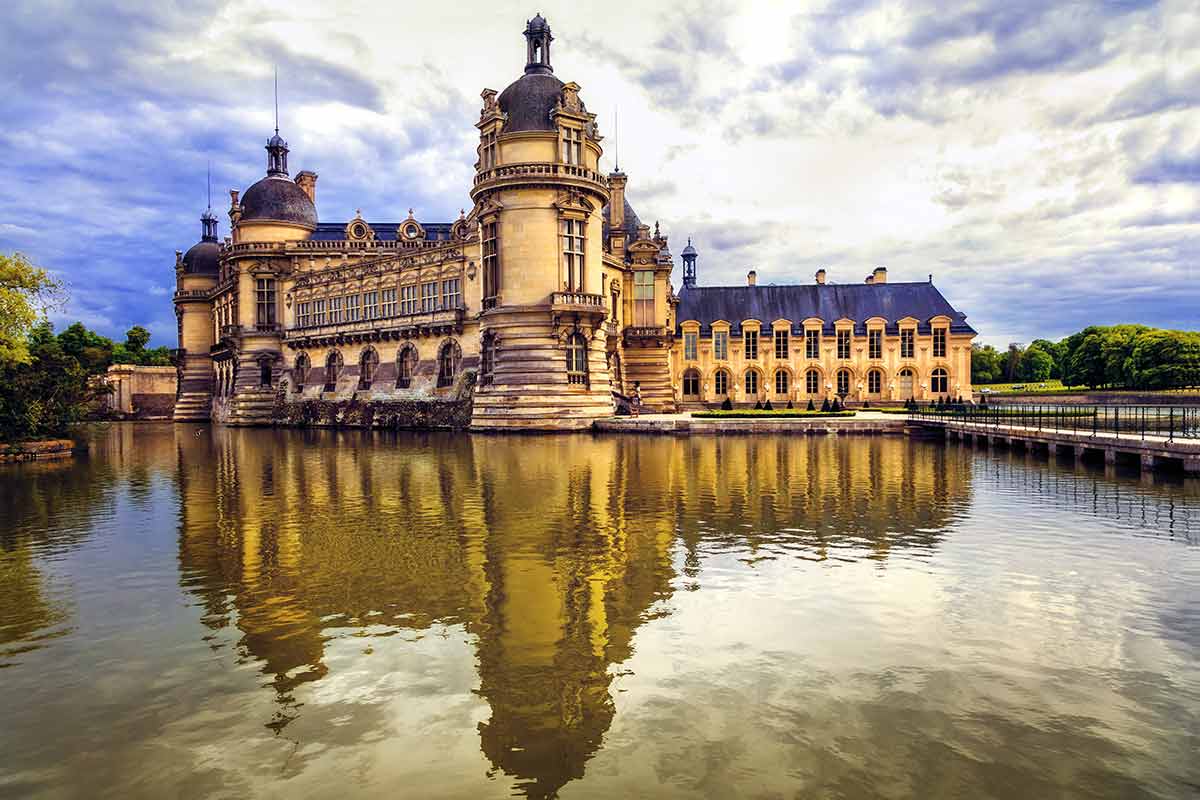
Completed on 31 March 1889, for 41 years the Eiffel Tower held the title of the world’s tallest manmade structure until New York’s Chrysler Building took over in 1930.
Today, the 324 m tower is still the tallest structure in Paris and is one of the most visited monuments in the world.
Seven million people a year pay to climb the Eiffel Tower and while you can walk the 1665 steps to the top, taking the lift is so much easier.
These lifts are one of the things that make this Paris landmark such a popular one.
Combined, the lifts travel 2.5 times the circumference of the globe each year.
The architect and engineer who designed the tower, Gustave Eiffel, would have been proud that this world-famous landmark has received over 250 million visitors since it opened.
The Eiffel Tower is one of the most significant landmarks in the world and is so famous there are theme park replicas in Las Vegas, Macau and China.
Weighing 10,100 tonnes, you’d be surprised to learn that it only took a little over two years to build.
A quirky fact about the Eiffel Tower is it shrinks when the weather is cold.
The Eiffel Tower is in the 7th arrondissement in Paris. Take the Metro to Champ de Mars on Line RER C, Ecole Militaire on Line 8, and Bir-Hakeim on Line 6. Skip the ticket line and enjoy access to the first and second floors as well as the summit.
Stay at: Chic Parisian Flat
2- Musée du Louvre
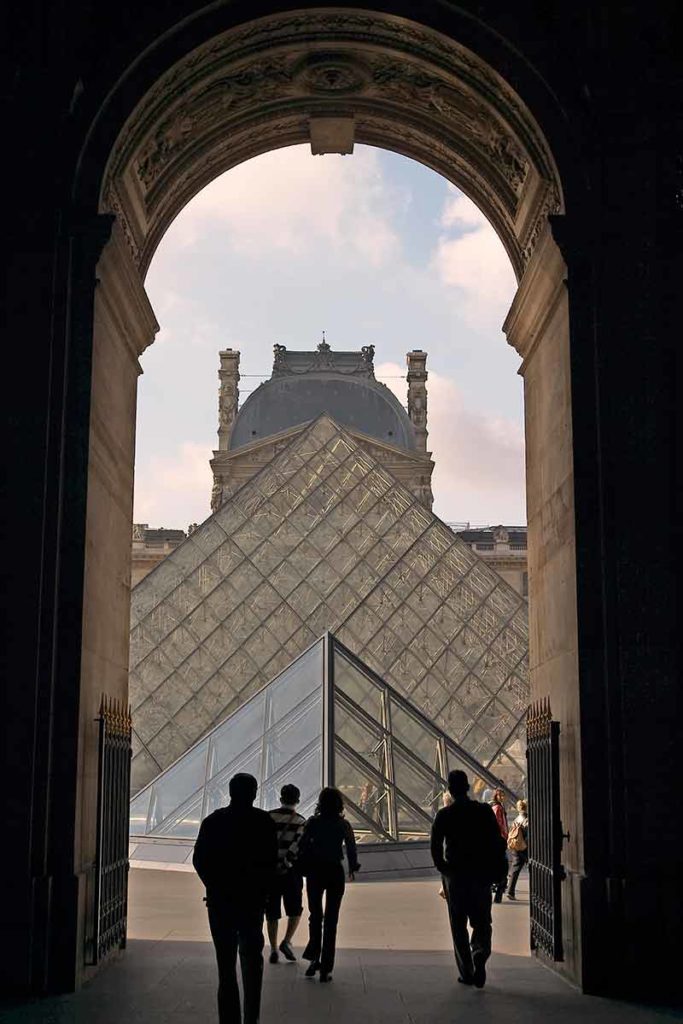
France’s national museum and art gallery, Musée du Louvre, is one of the most famous landmarks in France the most visited art museum in the world.
The Louvre is in a 12th-century palace in Paris that was the residence of France’s royal family.
It became a museum in 1793, after the French Revolution, and is now a showcase of the world’s best artworks including the Mona Lisa.
With 35,000 works of art on display, spanning a history of 7000 years, visiting the Louvre can take days to explore the numerous galleries within the palace as well as the Carrousel and Tuileries gardens.
Some of the artworks to see in the Louvre are Ancient Greek sculpture Venus de Milo, which is the most famous interpretations of female beauty, the massive painting of the Coronation of Napoleon and Leonardo da Vinci’s Mona Lisa.
In 1984, architect I.M. Pei created a new entrance to the Louvre that caused some controversy because it’s a contemporary steel and glass pyramid.
The Louvre is at 75058 Paris and is open every day from 9 am to 4 pm (except Tuesday). Take the Metro to Palais-Royal Musée du Louvre (lines 1 and 7). Skip the ticket line and join a tour of The Louvre.
Stay at: Hotel La Villa Saint Germain Des Prés
3- Arc de Triomphe
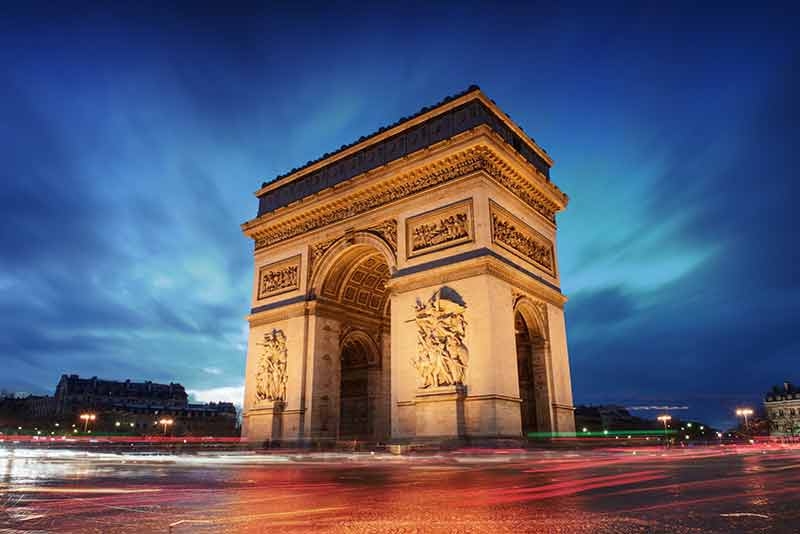
The Arc de Triomphe is a famous historical monument of France, erected in to honour the French soldiers who gave their lives to serve their country.
Conceived by Napoleon, to honour the French army, it was completed on 29 July 1836, long after Napoleon’s death.
The Arc de Triomphe was the largest arch in the world for over 100 years and at 51 m high, it’s currently the second-largest (there’s a larger one in Pyongyang, North Korea).
At the base of the arch is the Tomb of the Unknown Soldier, sculpted roses which adorn the ceiling of the archway and the 128 battles of the First French Republic (Napoleon’s Empire) are on the walls.
Climb the steps leading to the top of the Arc, where you’ll feel on top of the world.
There are virtual reality terminals and 3D movies to help visitors learn about the monument’s history of this iconic monument.
Arc de Triomphe is in the 8th arrondissement in Place de l’Etoile, Paris. It’s open daily from 10 am and closes at 11 pm (1 April to 30 September) and 10.30 pm (1 October to 31 March). Skip the ticket line and pre-purchase your tickets here.
Stay at: Paris j’Adore Hotel & Spa
4- Notre Dame de Paris
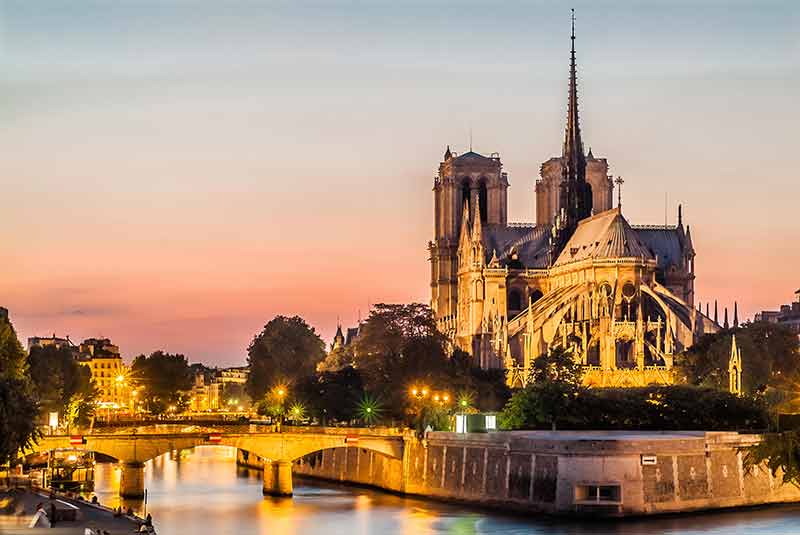
Notre Dame de Paris is, another famous landmark in France, was ravaged by a that caused its spire to collapse.
Before the April 2019 fire destroyed Notre Dame’s spire, millions of visitors flocked to Notre Dame to gaze at its twin towers, to see the Crown of Thorn Relic and admire the Gothic architecture.
Fortunately, the priceless artefacts, including a collection of artwork and holy objects, were saved.
Among the priceless treasures occasionally displayed to worshippers was the crown of thorns, the thorn wreath that was placed on Jesus Chris’s head at his crucifixion.
Notre Dame took 200 years to build (1163 until the 1300s), although the first Mass in the cathedral was in 1182.
The cathedral hit the public eye again when Victor Hugo’s “The Hunchback of Notre Dame” was published in 1831.
Notre Dame de Paris is currently closed.
To date, the French government has received pledges from 350,000 donors amounting to €922 million while the Notre Dame Foundation has received €104 million to put towards renovating this priceless landmark in France.
Stay at: Maison Cardinal Furstemberg
For more amazing European Landmarks, read:
- 31 Spain Landmarks
- 31 Switzerland Landmarks
- 26 Germany Landmarks
- 35 London Landmarks
- 30 France Landmarks
- 20 Italy Landmarks
- 26 Greece Landmarks
- 30 Russia Landmarks
- 20 Scotland Landmarks
- 40 Ireland Landmarks
- 21 Wales Landmarks
- 23 Turkey Landmarks
- 20 England Landmarks
- 20 Hungary Landmarks
- 21 Romania Landmarks
- 20 Ukraine Landmarks
- 23 Athens Landmarks
- 20 Rome Landmarks
- 41 England Landmarks
- 31 Portugal Landmarks
- 25 Poland Landmarks
- 24 Iceland Landmarks
- 21 Bulgaria Landmarks
- 21 Croatia Landmarks
- 20 Bulgaria Landmarks
- 23 Austria Landmarks
- 21 Finland Landmarks
- 24 Sweden Landmarks
- 20 Denmark Landmarks
- 20 Belgium Landmarks
- 21 Netherlands Landmarks
- 20 Barcelona Landmarks
- 21 Czech Republic Landmarks
- 30 Landmarks in Paris
- 21 Landmarks in Liverpool
- 10 Istanbul Landmarks
5- Basilica de Sacre Coeur
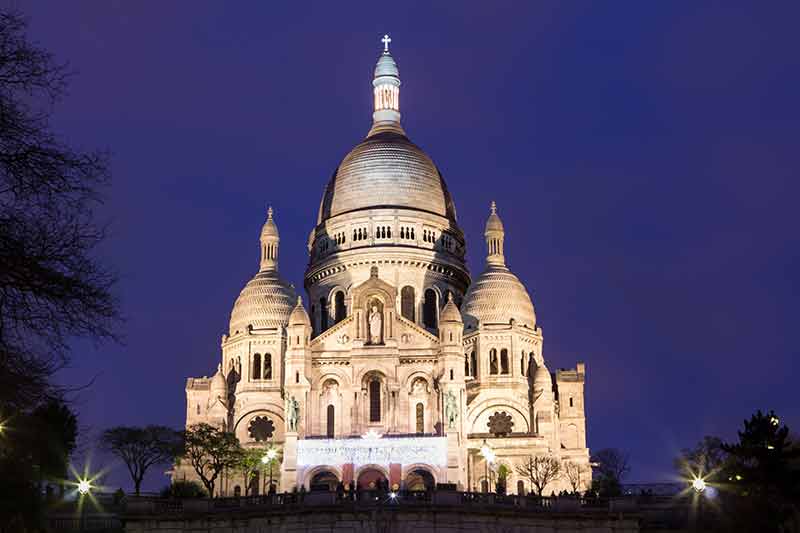
Basilica of the Sacré-Coeur is a stunning Romano-Byzantine monument in Paris that sits high on Montmartre hill.
Even if you’re not keen to spend time in a Basilica, it’s worth visiting as being on a hill makes it the second-highest point in Paris.
Designed in the vein of Saint Sofia in Constantinople and San Marco in Venice, Sacré-Coeur has four domes and the largest (and heaviest) bell in the world.
The Basilica’s bell weighs 19 tons, and it took 21 horses to pull it up the hill.
Completed in 1873, to pay respects to the victims of the 1871 war with Prussia, the Basilica has a fantastic view of Paris.
Access to the Basilica is free but there’s a fee to visit the dome, from which you’ll have a panoramic view of Paris.
Other impressive features are its mosaic floor at the entrance and the crypt.
The best time to soak up the atmosphere is to attend Christmas or New Year’s Eve Mass.
Basilica de Sacre Coeur is at Esplanade of the Basilica, Paris. Opening hours are 6 am to 10.30 pm and entry is free. Take the Metro to Jules Joffrin (M° 12) and the Montmartrobus bus to the Place du Tertre stop.
A great way to explore is to do this hidden gems tour of Montmarte.
Stay at: Quartier Libre Opera
6- Centre Pompidou
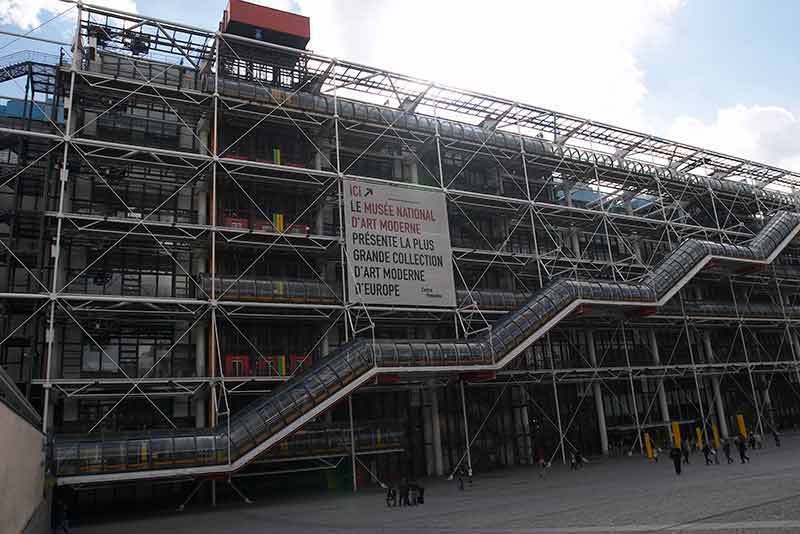
Amidst Paris’ treasure trove of Gothic and Baroque treasures, the Centre Pompidou (named after George Pompidou, President of France from 1969 to 1974) stands out as a contemporary architectural landmark in France.
Designed by Renzo Piano and Richard Rogers, this 20th-century building opened on 31 January 1977, and cost 993 million French francs to build.
While it’s not aesthetically beautiful in a classical sense, the eye-catching design reflects the Industrial Age, with creative elements like colourful pipes and caterpillar escalators outside the building.
The futuristic building is home to a rotating programme of interesting art exhibitions, a museum displaying contemporary pieces, live shows, a cinema, workshops and debates on thought-provoking subjects.
The centre’s collection of 100,000 works covers the spectrum of what is considered modern art, including visual arts, new media, film, industrial design, photography and architecture.
This contemporary French landmark is not just an eye-piece. There are workshops, tours and hands-on activities for kids too.
Check the latest programme here and if you want to explore more of Paris on foot, Le Marais is only a few minutes away.
Centre Pompidou is at Place Georges Pompidou, 75004 Paris. Opening times are 11 am to 9 pm daily and until 11 pm on Thursdays. Buy your ticket here.
Stay at: Hotel Dupond-Smith
7- Pont Neuf
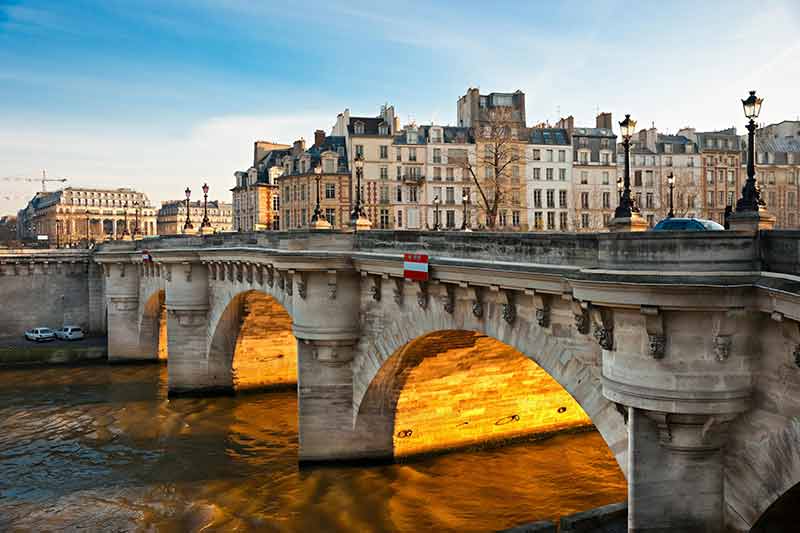
Paris is a city of bridges but if you had to choose one, Pont Neuf is the bridge that is one of the iconic landmarks in France.
It’s the oldest standing bridge across the Seine and stands near the western side of Île de la Cité, the island that is considered the birthplace of Paris.
In Medieval times, around 250 BC, this island was known as Lutetia and was the hub of the city.
The bridge has 12 arches, 384 mascaron carvings and a statue of Henri IV who was the French King at the time the bridge was completed in 1607.
The mascarons are the stone faces from ancient mythology and are copies of the originals created by Germain Pilon (1525 to 1590).
During the 19th century, the original mascarons were placed in museums for safekeeping and copies were made by several famous 19th- century sculptors including Fontenelle, who created 61 faces.
Pont Neuf connects the left bank with the right bank via Ile de la Cité and is a popular meeting place for tours of nearby landmarks in Paris.
A great way to explore Paris and save your feet is to take the hop-on-hop-off bus.
Stay at: Villa-des-Prés
8- Place de la Concorde Fountains and Luxor Obelisk
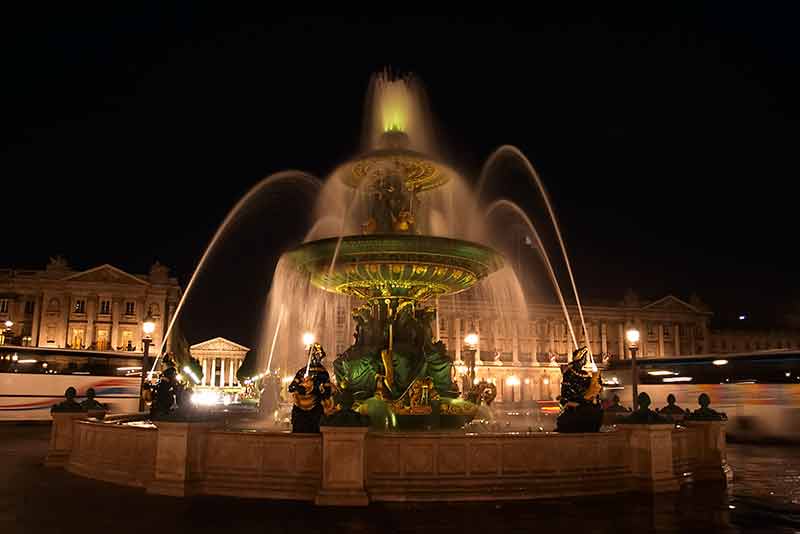
Place de la Concorde, which has been home to a 3300-year-old Luxor Obelisk since 1836, is a pleasant place to go for a stroll and popular spot for a distant view of the Champs Elysee.
The two Fontaines de la Concorde were completed in 1840 during the reign of King Louis-Philippe.
Fontaine des Mers and Fontaine des Fleuves represent France’s dominance in maritime commerce and river navigation.
The significance of these historic landmarks of France is that during the French Revolution, the name of the square was changed from Place Louis XV to Place de la Revolution as this was where King Louis XVI and Marie Antoinette were guillotined in 1792.
The King and Queen weren’t the only ones to face the guillotine at Place de la Concorde.
During that time, 1,119 of the 2,498 people guillotined in Paris had their heads chopped off here, making it one of the famous landmarks with a gruesome history.
Place de la Concorde is at the end of the Champs-Elysées in Paris, which is a vibrant boulevard with stylish shops and the best shows in Paris.
Stay at: Hotel de Crillon
Famous Landmarks In France
9- Château de Fontainebleau
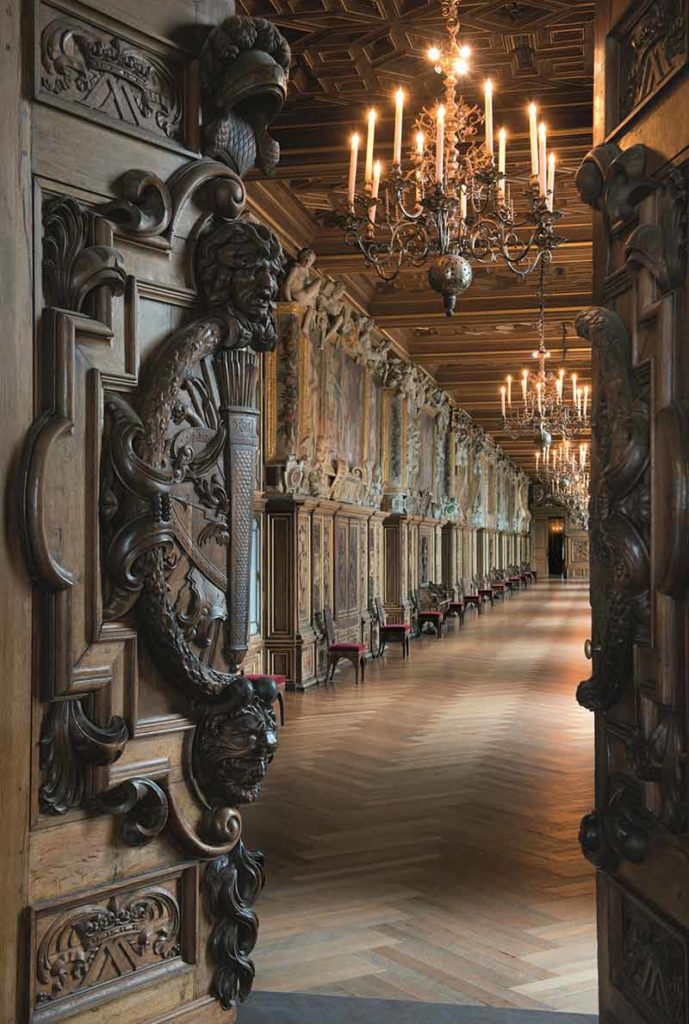
Originally a 12th-century hunting lodge, Fontainebleau has been a royal residence of 34 French sovereigns.
In the 16th century, King François I began transforming Chateau de Fontainebleau into a palace and every subsequent king has made modifications to the sprawling French landmark.
That’s why the layout of five courtyards surrounded by a wide variety of buildings representing 12th to 19th-century architectural styles is a mishmash of opulent architecture and design.
As Italian and French artists were commissioned to work on the Palace of Fontainebleau, it played a huge part in the development of art in Europe.
Notable events in history that occurred in Fontainebleau include Napoleon I’s abdication in 1814 and Louis XIV’s repeal of the Edict of Nantes (1685) when he ordered the destruction of Huguenot churches and the closure of Protestant school.
When visiting Fontainebleau, things to see are The Apartments (including two Marie Antoinette boudoirs and Papal Apartment), three chapels, galleries, theatre, four museums and a collection of masterpieces.
Don’t miss Marie Antoinette’s bed and Napoleon’s throne.
Another fantastic way to see Fontainebleau is from the sky in a hot air balloon.
Fontainebleau is at Seine-et-Marne department in the Île-de-France region. Opening hours at Fontainebleau are 9.30 am to 5 pm (October to March), and 9.40 am to 6 pm (April to September) every day except Tuesdays. Book your ticket here.
Stay at: Gîtes Isatis
10- Palace of Versailles
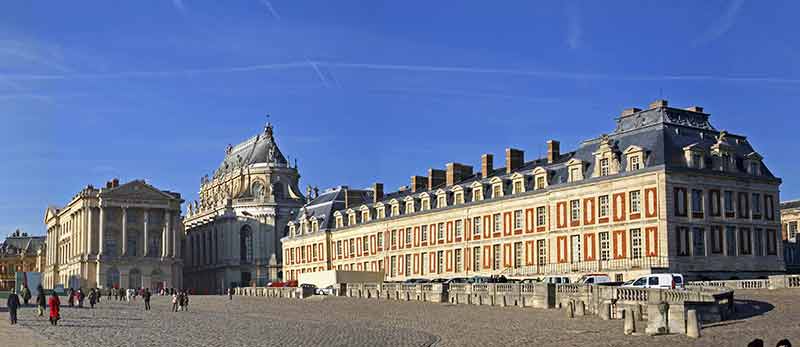
Built by the Sun King Louis XIII, the Palace of Versailles saw its heyday during the reign of Louis XIV (1638 to 1715) who brought the French court to Versailles.
During his reign, Louis XIV transformed Versailles from hunting lodge to an opulent palace fit for a king to entertain, throw decadent parties in the ballroom and gardens.
Versailles was also where Louis XVI was married to Marie-Antoinette in 1770 but after the French Revolution, it became a museum in 1837.
A tour of the Palace of Versailles is a step back into an extravagant era of France’s rich history and a chance to see how royalty lived.
It’s a gem on UNESCO’s World Heritage list that is a pleasure to explore.
You can walk through extravagant bedrooms, the famous Hall of Mirrors and the lovely gardens.
While the buildings and grounds of the Palace of Versailles (it has 700 rooms) itself is reason enough to visit, there’s also a collection of 60,000 works from the Middle Ages to the 19th century on display.
Palace of Versailles is at Place d’Armes, 78000 Versailles, France. Opening hours 9 am to 5 pm daily, except Mondays. If you’re keen on seeing the Coach Gallery and estate of Trianon, keep in mind they are only open in the afternoon. Skip the queues with this ultimate Versailles tour.
Stay at: The Peninsula Paris
11- Mont Saint Michel
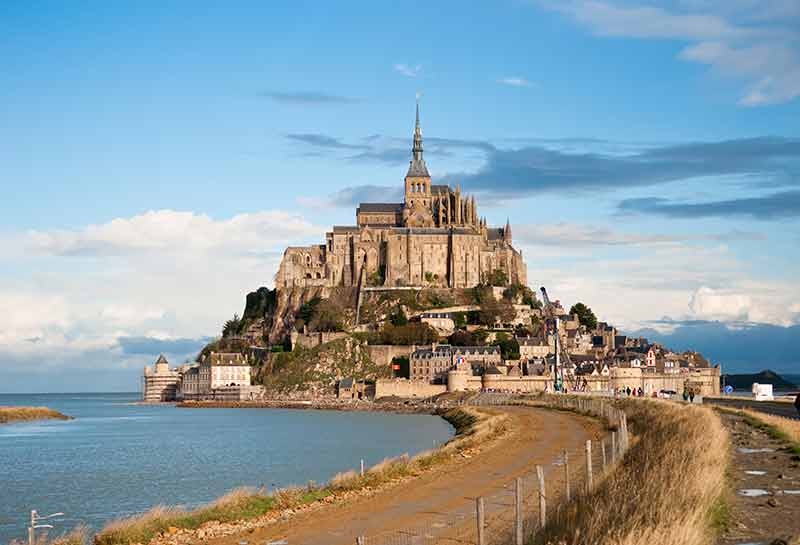
Mont Saint Michele Abbey in Normandy is a mystical French landmark atop a rock, which becomes a beautiful island when the tide comes in.
On a misty day, this UNESCO World Heritage site of Mont Saint Michel looks like a magical castle out of a fairy-tale, with a golden statue of Archangel Michael sits on its spire.
The first building was erected in 708. After the Benedictine monks moved to the Abbey in 966, it became a European centre for pilgrims due to the successful efforts of the monks of the Order of Saint Benedict.
During the French Revolution, Mont Saint Michel was a prison.
A section of the Abbey pays tribute to the 5th century cult of Saint Michael, the chief of the angels who, according to Book of Revelations, killed a demon dragon.
These days, Mont Saint Michel is one of France’s most visited tourist attractions, with many cafes and hotels nearby.
Mont Saint Michel Abbey is at the mouth of the Couesnon River in Normandy. Book your pass to four museums at Mont Saint Michel. Visit Mont Saint Michel on a day tour from Paris.
Stay at: Château de Boucéel – Mont Saint Michel
12- Palais des Papes
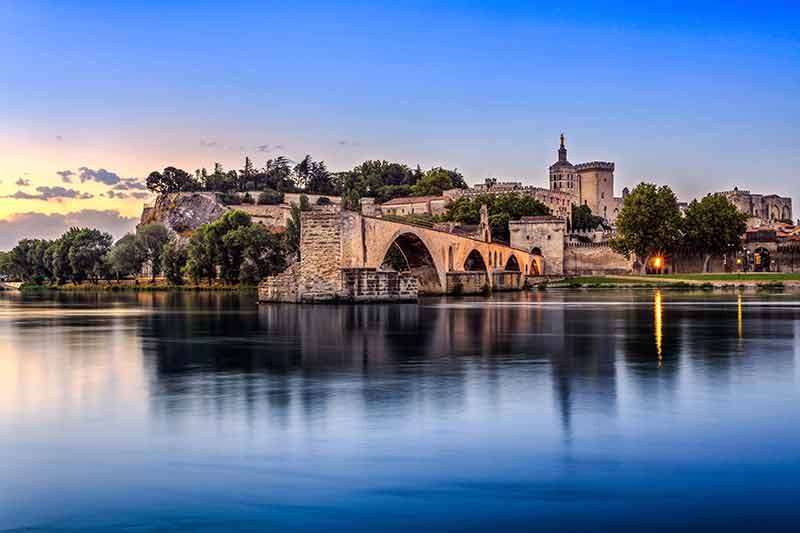
In the 14th century, Avignon became the headquarters of the papacy and Palais des Papes a landmark of France that cemented its position in the Christian world.
The decline of the political power of the Holy See in Rome resulted in Clement V, the pope who was responsible for persecuting the Order of the Knights Templar, moving the papacy to Avignon.
Avignon remained as the seat of the papacy between 1309 to 1377.
Construction of The Palace of Popes was completed over 20 years, during the reigns of Benedict XII and Clement VI.
Given its important role in history, it’s not surprising Palais des Papes is a UNESCO World Heritage Site and one of the most famous buildings in France.
It’s also Europe’s largest medieval fortress and gothic palace.
The palace was the seat of 9 popes before the papacy returned to Rome.
Visitors can explore the ceremonial halls, courtroom, private apartments of the popes and Matteo Giovannetti’s frescoes in the chapels.
There are also significant cultural events, exhibitions, concerts and the Luminescences light festival is held here from August to October.
Palais des Papes is in Place du Palais, 84000 Avignon, on the banks on the Rhône River in the Provence-Alpes-Côte-d’Azur region, Avignon. Discover this gem on a walking tour of Avignon.
Stay at: Palais des Papes – Havre de Paix III
13- Basilica of Notre-Dame de Fourvière
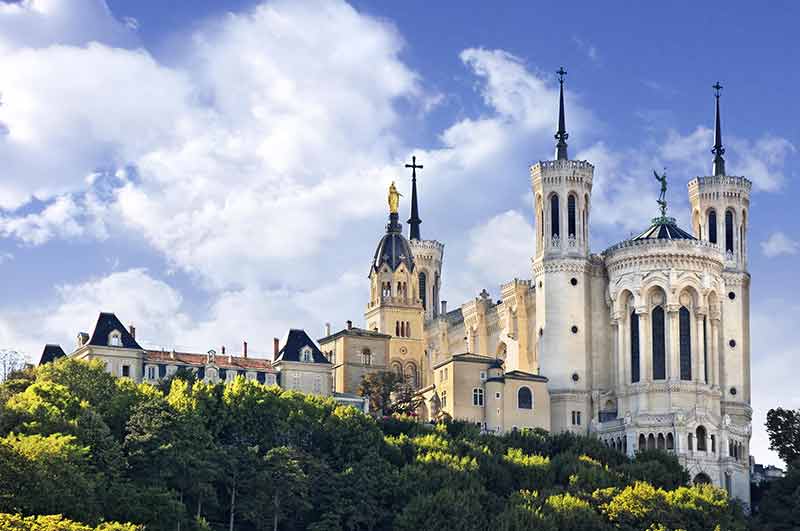
Basilica of Notre-Dame de Fourvière graces the skyline of Lyon and has a fabulous view of the city.
So, it’s not surprising that the Romanesque and Byzantine architecture of the Basilica draws a huge crowd each year, making a visit to the Basilica one of the things to do in Lyon for its architecture and a stunning view of the city.
Fondly referred to by locals as the upside-down elephant, the Basilica is not just a symbol of Lyon but a famous France landmark in its own right.
Located at the confluence of the Saône and the Rhône Rivers, Lyon was a Roman city during the 1st century BC and the capital of Trois Gaules (Roman France).
Basilica of Notre-Dame de Fourvière is at Place de Fourvière, 5e 69005 Lyon, France. Opening hours are from 7 am to 7 pm. Explore the Basilica and other sights in Lyon with this hop-on hop-off tour.
Stay at: Villa Florentine
14- The Walls of Carcassonne
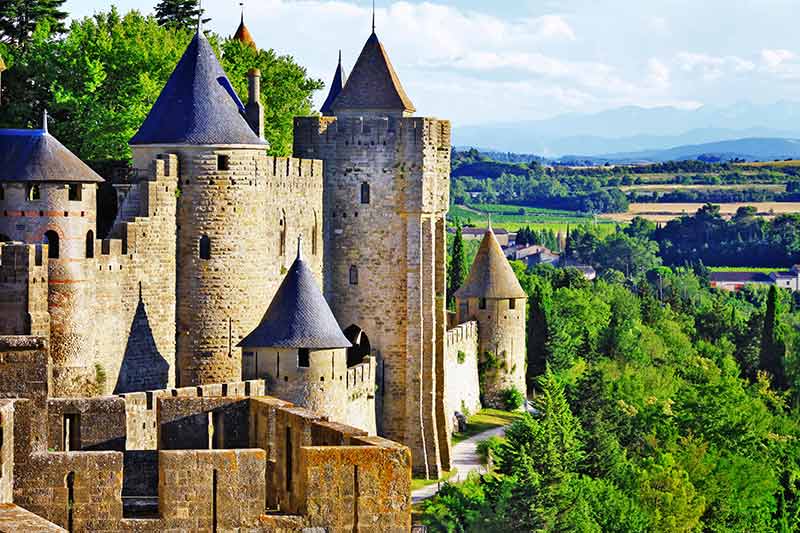
The medieval citadel of Carcassone, with its watchtowers and double-walled fortifications, is one of France’s the most famous buildings dating back to Roman times.
With 3km of walls, Carcassonne is the largest walled city in Europe.
Although the first walls were constructed in Roman times, additions were made in in the 13th and 14th centuries.
Highlights in the citadel include Château Comtal, a 12th-century castle, and a Medieval village.
The Historic Fortified City of Carcassonne is in Carcassonne, Aude, Occitanie, France. Beat the queues and book a private tour.
Stay at: Maison Thérèse by Panorama Locations
15- Pont du Gard
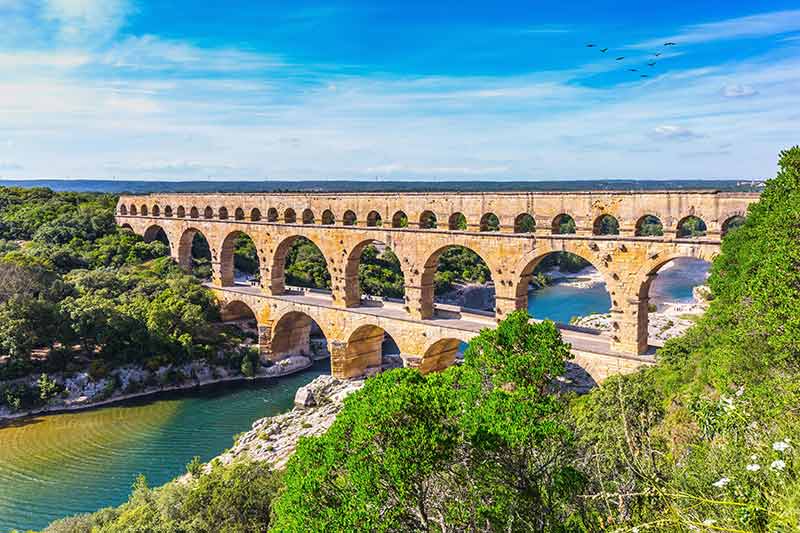
Pont du Gard is a tri-level aqueduct that crosses the Gardon River for 275 m connecting Uzès and Nîmes.
This marvel of Roman engineering is around 2000 years old and winds through the mountains for 50 km.
The aqueduct has supplied water to Nîmes for five centuries.
Visit the museum on the left bank of the river to learn about the aqueduct’s history and impressive features that make it one of the significant UNESCO World Heritage landmarks in France.
The Point du Gard museum is at La Bégude, 400 Route du Pont du Gard, Vers-Pont-du-Gard, France. It’s a year-round destination.
Stay at: Château de Collias
Discover more Famous World Landmarks:
- 30 Australian Landmarks
- 20 New Zealand Landmarks
- 22 African Landmarks
- 21 Egyptian Landmarks
- 20 Jordan Landmarks
- 10 Tasmanian Landmarks
- 20 Antarctica Landmarks
16- Mont Blanc
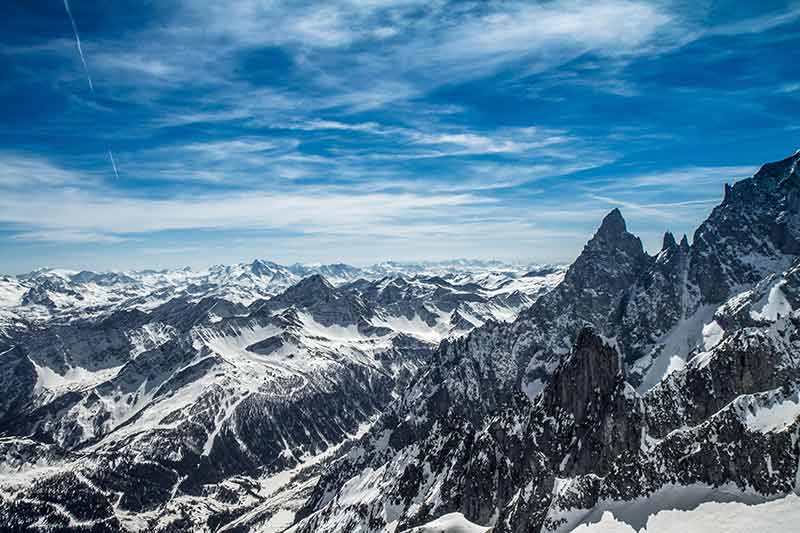
Considered one of the most famous natural landmarks in France, Mont Blanc (4810 m/15 780 ft) high is the highest peak in the Mont Blanc massif, which has 11 summits over 4,000 metres (13,123 ft) high.
The Mont Blanc massif is part of the Alps and stretches 46 kilometres (29 miles) across France, Italy and Switzerland.
The mountain itself is on the France – Italy border.
How was Mont Blanc created? The northward movement of the African plate pushed up the ground tens of millions of years ago and created Europe’s highest peaks.
About 20,000 people attempt to climb Mont Blanc every year but you don’t have to be a mountain climber to enjoy the mountain.
The most comfortable way to see Mont Blanc is to board the Panoramic Mont-Blanc Gondola to Aiguille du Midi (3842m), which is home to one of the world’s highest museums.
Another option is to stop off at Plan de l’Aiguille (2,317m) for off-piste skiing, paragliding and rock-climbing activities.
Musée de l’Alpinisme Pointe at Aiguille du Midi is in a rocky chamber inside the mountain.
Another way to experience Mont Blanc is to board Tramway du Mont-Blanc, which is France’s highest rack railway, at Le Fayet or Saint-Gervais.
The train stops at Bellevue, which is 1 900 m (6,233) and Nid d’Aigle at 2 372 m (7,782 ft).
Chamonix is the closest city to explore Mont Blanc from.
Stay at: Armancette
17- Château de Chenonceau
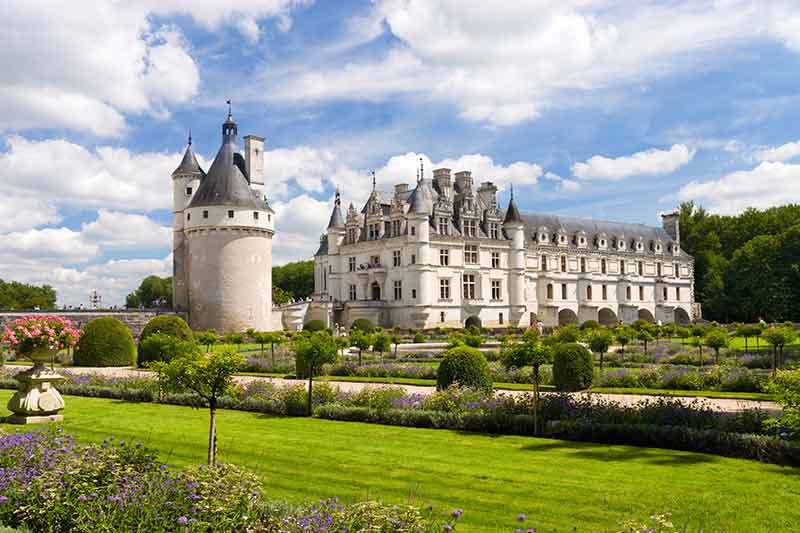
The Château de Chenonceau is another of those French landmarks with an intriguing past.
It was rebuilt between 1514 and 1522 by Thomas Bohier and his wife, Catherine Briçonnet and the only part of the original 12th-century Chateau that is left is its dungeon.
Francis I seized Chenonceau and later offered by his successor Henri II to his former governess turned mistress, Diane-de-Poitiers who planted gardens and erected the bridge across the river.
After the Henri II died, the Queen, Catherine de Médici grabbed it for herself and threw wild garden-parties.
Visiting Château de Chenonceau is a step back into a romantic era, with opulent furnishings and famous artworks from the 16th to 18th centuries.
Château de Chenonceau is near the small village of Chenonceaux in the Indre-et-Loire département, Loire Valley, France. It’s one of the lovely castles to visit on a tour.
Stay at: LA MAISON LEONARD
18- Château de Chambord
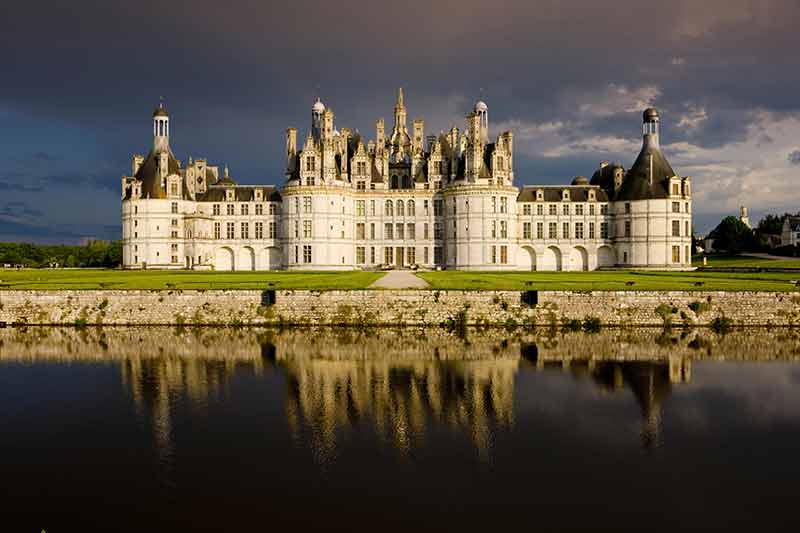
Château de Chambord is a landmark of France of monumental scale, with a soaring 156 m façade and towers.
The Chateau has 440 rooms (not all of them have furniture, as the French court moved around), backstairs and hidden passages.
Chambord is the largest château in the Loire Valley and possibly the most impressive.
Francis I built it to show off the power of the French crown and used it to host European royalty.
In 1792, the French Revolution changed France forever and many of Chateau de Chambord’s furnishings were sold.
During World War II, the Chateau was used to store artworks from the Louvre for safekeeping.
Château de Chambord is celebrating its 500th anniversary in 2019. Opening hours are 9 am to 6 pm (30 March to 27 October), and 9 am to 5 pm (28 October to 29 March). Take a Loire Valley Castle Tour for an experience to remember.
Stay at: Fleur de Loire
19- Chateau de Chantilly
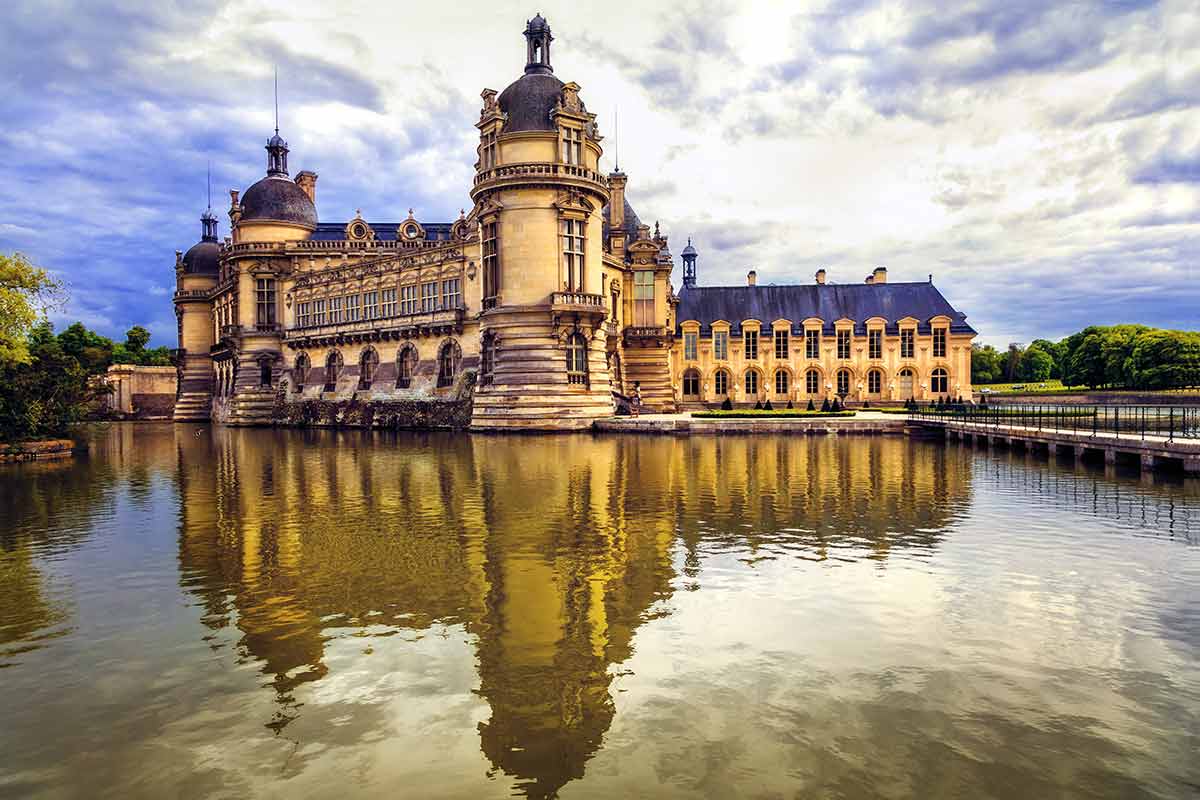
Located at the confluence of two rivers, the Oise and Seine, Château de Chantilly is a beautiful stone chateau with lovely gardens and extensive stables built for 240 horses, grooms and hunting dogs.
The grand chateau was designed in 1560 by Jean Bullant, who was also the architect for members of the French court.
In the 18th century, cousins of Louis XV bought the chateau and it became the home of the Condé family.
Paintings of the Condé victories during the 17th century are on display in the chateau’s apartments and gallery.
Like many other grand properties, authorities moved the chateau’s art to the Louvre during the French Revolution while it served as a prison.
These days, the chateau is home to Musée Condé, which has an impressive collection of paintings by the old masters and a library of manuscripts.
Chateau de Chantilly is 50km from Paris in Chantilly.
Stay at: Manoir des Cavaliers
20- Place Massena
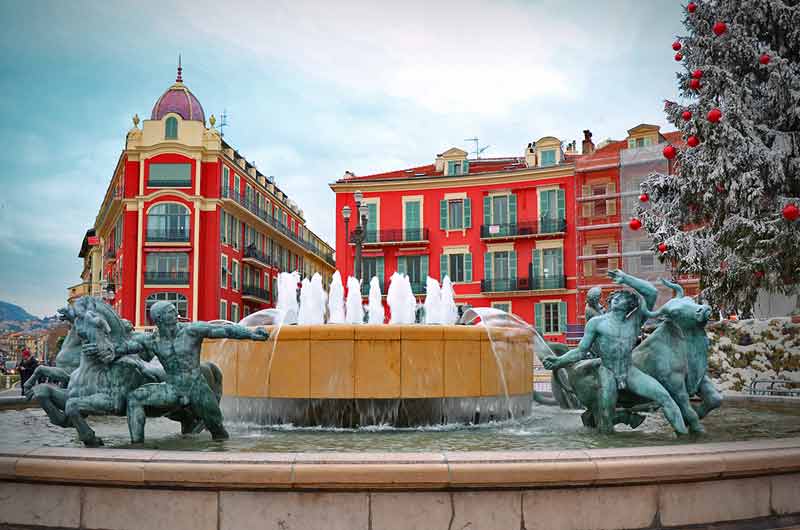
Place Massena in the main square of Nice was built over the Paillon river and is a famous landmark of France with Nice’s main shopping street leading into it.
The square is a popular place for events and carnivals and is home to several beautiful buildings.
The river used to flood the city and in the 19th century, a bridge connected two squares.
Place Massena is in Nice in Southern France.
Stay at: Hôtel du Couvent
21- Place de la Bourse in Bordeaux
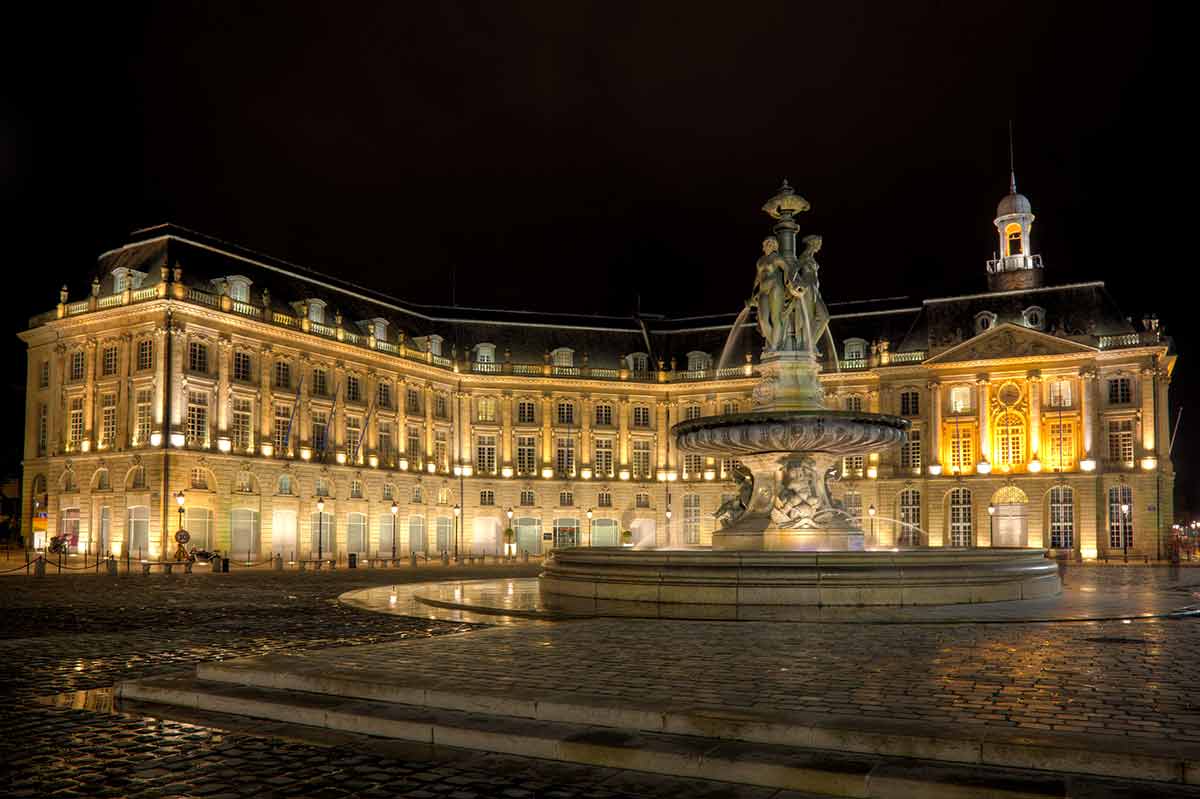
Place de la Bourse in Bordeaux is an 18th-century square along the Garonne River.
The city’s main square is a historic landmark of France that played a role in the development of Bordeaux.
The elegant square took 20 years to build and was designed by one of Louis X’s architects, Jacques Gabriel.
Iconic buildings around the square include Hôtel des Fermes and Hôtel de la Bourse.
Place de la Bourse’s statues have evolved over the centuries, starting with the French King riding a horse, then one of Napoleon.
These days, the Fountain of Three Graces is a beautiful French icon in the centre of the square.
Place de la Bourse is in Bordeaux.
Stay at: Villa Reale
22- Cistercian Abbey of Fontenay
This monastery in Burgundy was founded by St Bernard in 1119 and is one of the landmarks in France where you can learn about Cistercian monks.
The Abbey was built between 1139 and 1147 and is a display of austere architecture.
What makes the Cistercian Abbey of Fontenay unique is that it was the perfect spot for communal living, as a hub for agricultural, industry and a place of worship.
The cloister and the chapter house have remained intact through the centuries and there are other communal buildings to see, such as monks rooms, ironworks, bakery and refectory.
Cistercian Abbey of Fontenay is in the Bourgogne Franche-Comté region in the Côte-d’Or department in the commune of Marmagne.
Stay at: Domaine Les Hauts Prés
23- Tour First
You might be wondering if there are any modern landmarks in France and, actually, there are several multi-story skyscrapers.
The tallest building in France is Tour First – which is owned by the AXA insurance company – and is 231 m (758 ft) including its spire.
Located in the La Defense business district of Paris, the skyscraper is a gleaming modern building that was built in 1974.
Tour First is at 1-2 Place des Saisons, 92400 Courbevoie.
Stay at: Saint James Paris
24- Bourges Cathedral
Bourges Cathedral is located in one of the early Gaul Christian communities in Avaricum, an ancient Roman city.
Although a cathedral has stood on the site since the 3rd century, this Gothic version dates back to the 12th century.
The cathedral is a UNESCO World Heritage wonder and a stunning example of French Gothic architecture and Gothic art, with incredibly beautiful stained-glass windows, sculptures and a five-nave basilica.
When visiting, make sure to take your time to admire the lovely sculptures, especially the Door of the Last Judgement.
Bourges Cathedral is at Place Etienne Dolet, 18000 Bourges, France.
Stay at: Aux 3 Maillets
25- Pilat Dune
Another natural landmark of France, Dune du Pilat, stands at the entrance of Arachon Bay.
The dune is around 110 m (360 ft) high and 2.9 km (1.8 mi) long.
The sand comes from the mountain ranges of the Pyrenees and Massif Central when streams washed fine quartz grains to shore.
The forces of nature of waves and wind continuously change the height and shape of the dune each year.
The dune has several layers of sand and darker paleosols (old forest soils) and is best viewed at sunset when the the light is magical.
Pilat Dune is in the Nouvelle-Aquitaine region.
Stay at: Hotel La Co(o)rniche
26- Massif des Calanques
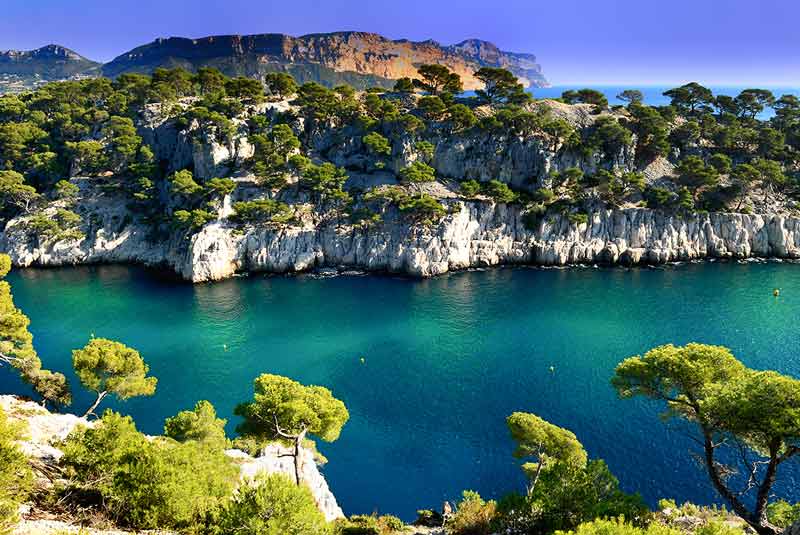
Stay at: App-Arte Marseille Vieux-Port
27- The Beach of Omah
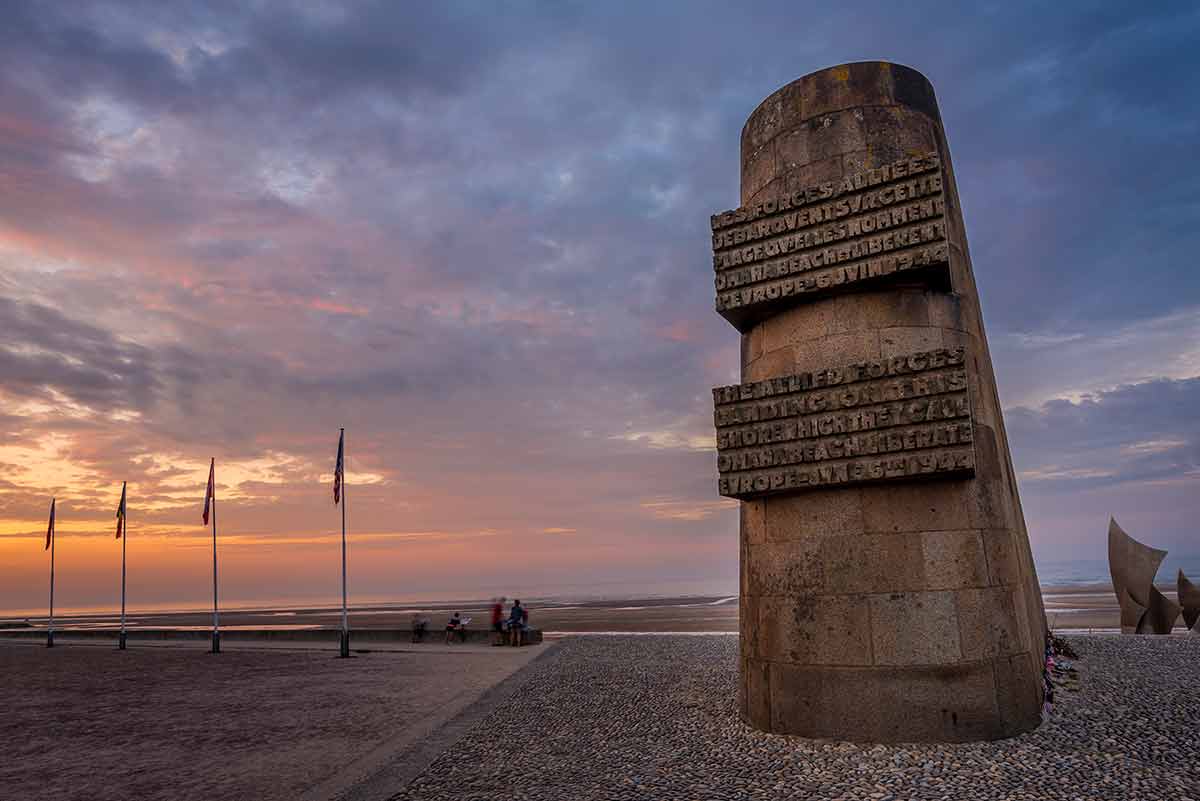
Omaha Beach is a historic D-Day destination in Normandy and one of the five beaches strategically split between the allies.
Omaha was where thousands of US troops were wounded and the Normandy American Cemetery and Memorial is where 10,000 soldiers are buried.
On the beach, there’s the bronze statue “Spirit of American Youth Rising from the Waves,” is a landmark in France that is a solemn reminder of this world-changing event.
Omaha Beach is in the Normandy region of France within the department of Calvados.
Stay at: Villa Lara Hotel
28- Strasbourg Cathedral of Notre Dame
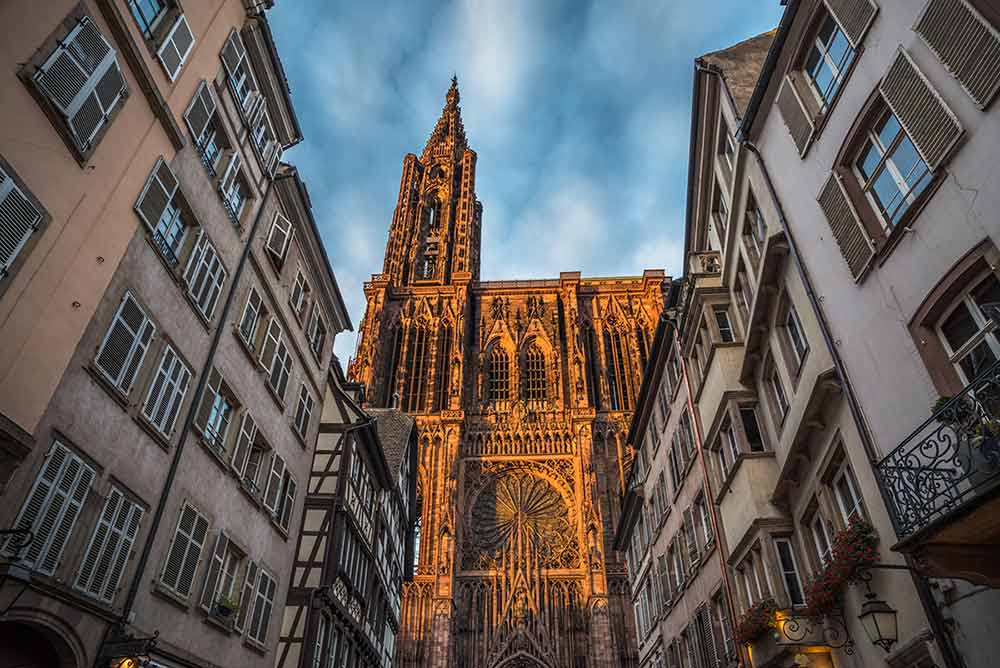
Strasbourg Cathedral is an architectural masterpiece that dates back to 1015.
It was reconstructed after a fire in the 12th century and has stunning Gothic architecture with beautiful stained-glass windows, sculptures, a massive church organ and an impressive astronomical clock.
Not only is the cathedral impressive to look at but it also has a stunning view of Strasbourg.
Strasbourg’s Notre Dame Cathedral is in the Grand Est region of the Bas-Rhin department.
Stay at: Pavillon REGENT PETITE FRANCE
29- European Court of Human Rights
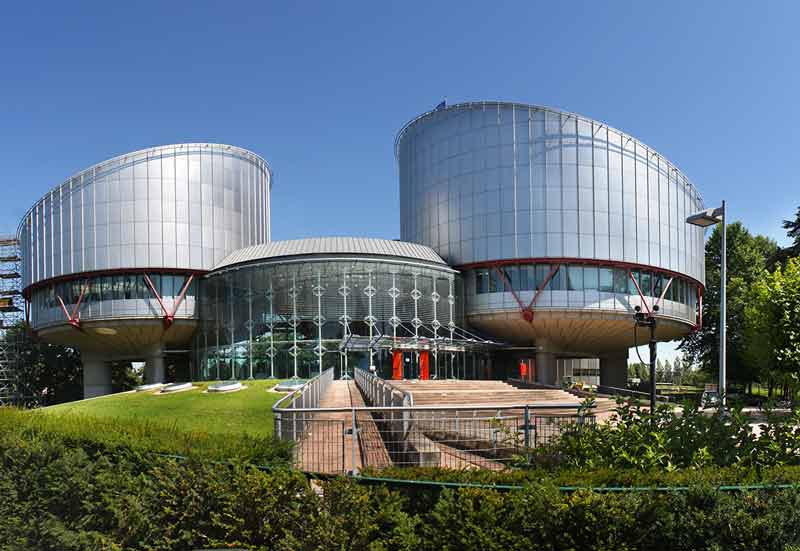
One of the more unique landmarks in France is the contemporary structure of the European Court of Human Rights.
The court was formed in 1959 to enforce the Convention for the Protection of Human Rights and Fundamental Freedoms, which was created by the European Council.
Signatories are required to guarantee a range of freedoms such as the freedom of its citizens to choose a religion, the freedom of expression and the right to a fair trial.
The court has the jurisdiction to award financial compensation and cases are heard by a panel of up to 17 judges, although the usual number of judges presiding over a case is seven.
European Court of Human Rights is at Allée des Droits de l’Homme, 67000 Strasbourg.
Stay at: La Ferme de Marie
30- Lavender Fields in Provence
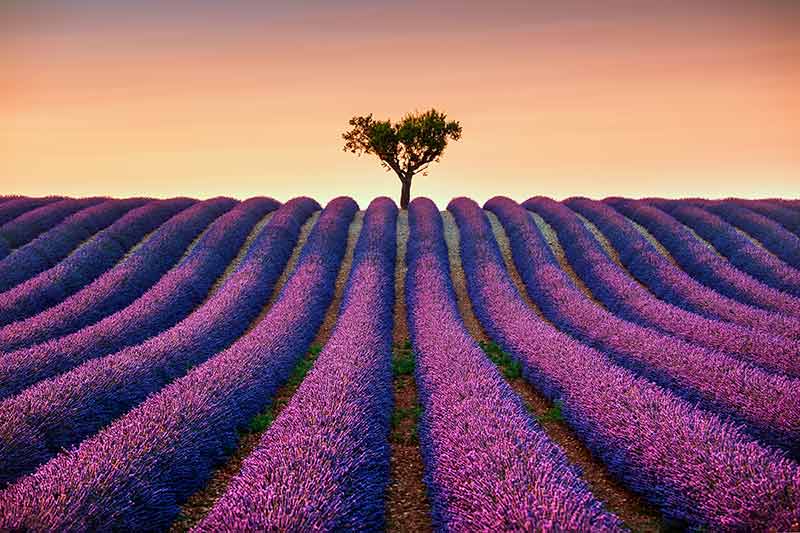
Provence is a sea of lavender in summer when the violet-coloured flowers bloom (around the middle of June to August).
Sault is the city of Lavender and is home to several attractions and the Valensole Plateau’s lavender fields are colourful landmarks of the Provence region to feast your eyes on.
The Lavender fields are in the Provence-Alpes-Côte d’Azur region.
Stay at: Le Couvent des Minimes Hôtel & Spa L’Occitane
For more about France, read:
- 30 France Landmarks
- 26 French Shows On Netflix
- 20 Castles In France
- 20 Beaches In France
- 20 Drinks In France To Try
- 20 Beaches In French Riviera
- 20 Amazing French Cities
- Food in France – 20 Dishes To Try
- Best Time To Visit France
- 15 Things France Is Famous For
- 20 Things To Do In Bordeaux
- 20 Luxury Hotels in Bordeaux
- 20 Things To Do In Marseille
- 20 Luxury Hotels in Marseille
- 20 Things To Do In Le Havre
- 20 Things To Do In Toulouse
- 20 Things To Do In Nantes
- 20 Things To Do In Dijon
- Paris in Winter
- 15 Things To Do In Nice
- 15 Things To Do In Lyon
- 20 Paris Landmarks
- 20 Things To Do In Paris At Night
- Le Marais Walking Tour
- 20 Paris Tours
- Lost in Paris
- L’Hotel Paris Review
- 20 Best Day Trips From Paris
- 20 Paris Winter Attractions
- 20 Paris Museums
- 20 Things To Do In Saint Tropez
- 20 Things To Do In Lille
- 17 Luxury Hotels in Lille
- 20 Things To Do In Strasbourg
- 20 Things To Do In Grenoble
- 20 Things To Do In Montpellier
- 20 Things To Do In Reims

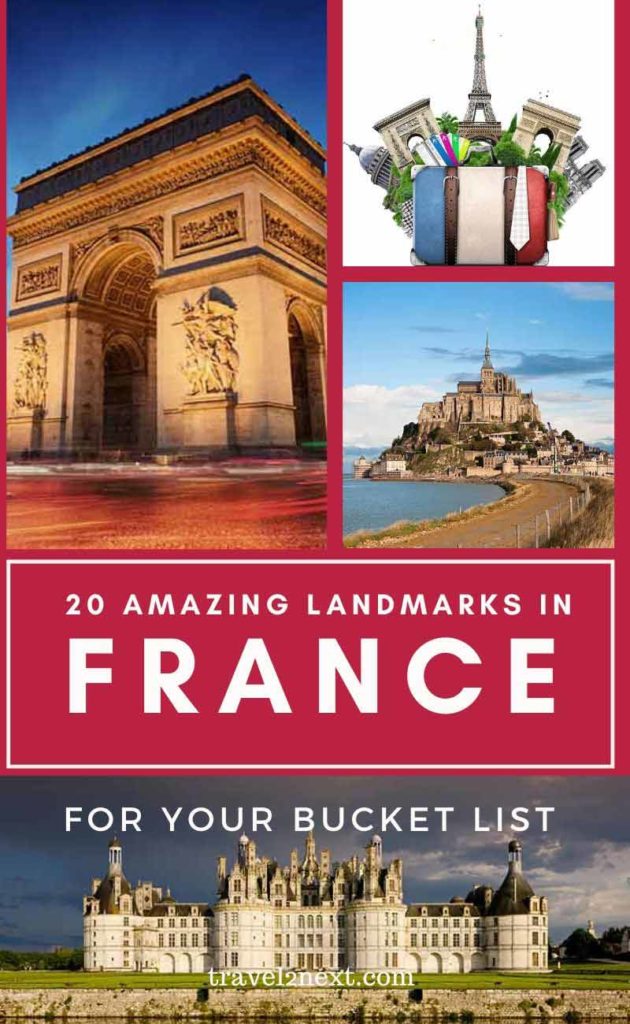
Plan Your Trip

Rent A Car – Find the best car rental rates at Discover Cars. They compare car hire companies to provide you with the best deal right now.

Find A Hotel – If you’re curious about this article and are looking for somewhere to stay, take a look at these amazing hotels.
